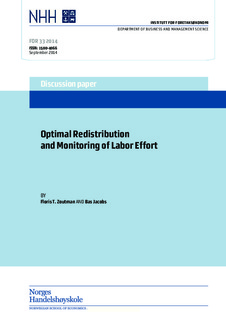| dc.contributor.author | Zoutman, Floris T. | |
| dc.contributor.author | Jacobs, Bas | |
| dc.date.accessioned | 2014-10-14T10:15:49Z | |
| dc.date.available | 2014-10-14T10:15:49Z | |
| dc.date.issued | 2014-09 | |
| dc.identifier.issn | 1500-4066 | |
| dc.identifier.uri | http://hdl.handle.net/11250/223706 | |
| dc.description.abstract | This paper extends the Mirrlees (1971) model of optimal non-linear income taxation with
a monitoring technology that allows the government to verify labor effort at a positive,
but non-infinite cost. We analyze the joint determination of the non-linear monitoring and
tax schedules and the conditions under which these can be implemented. Monitoring of
labor effort reduces the distortions created by income taxation and raises optimal marginal
tax rates, possibly above 100 percent. The optimal intensity of monitoring increases with
the marginal tax rate and the labor-supply elasticity. Our simulations demonstrate that
monitoring strongly alleviates the trade-off between equity and efficiency as welfare gains
of monitoring are around 1.4 percent of total output. The optimal intensity of monitoring
follows a U-shaped pattern, similar to that of optimal marginal tax rates. Our paper can
explain why large welfare states optimally rely on work-dependent tax credits, active labormarket
policies, benefit sanctions and work bonuses in welfare programs to redistribute
income efficiently. | nb_NO |
| dc.language.iso | eng | nb_NO |
| dc.publisher | FOR | nb_NO |
| dc.relation.ispartofseries | Discussion paper;33/14 | |
| dc.subject | optimal non-linear taxation | nb_NO |
| dc.subject | monitoring | nb_NO |
| dc.subject | costly verification ability/effort | nb_NO |
| dc.subject | optimal redistribution | nb_NO |
| dc.title | Optimal redistribution and monitoring of labor effort | nb_NO |
| dc.type | Working paper | nb_NO |
| dc.subject.nsi | VDP::Social science: 200::Economics: 210::Economics: 212 | nb_NO |
